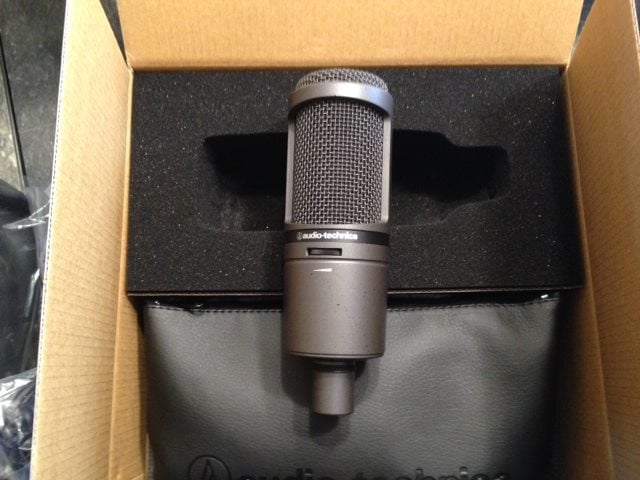[Editor’s Note: Back in August we put out a call for readers to win a cool recording bundle from our friends at Audio-Technica, consisting of the AT2020USBi Mic & ATH-M40x Headphones. We wanted someone to put these bad boys through their paces and report back on their findings. Below are the thoughts of one of the winners, Danielle Mazza, after using the gear for a few weeks in her home studio. We’ve also published the write-ups of our other winners, exclusively here and here.]
OK, first up…
THE ATH-M40x HEADPHONES
Well, I record a lot of lo-fi bands at my home studio, in a refurbished part of my home that’s solely dedicated to music production. Typically, I use closed-back Sony MDRV6 studio monitor headphones for tracking, and Grado SR-80s for imaging and general stereo listening (those feature an open design). My Sony cans have been underwhelming, to say the least, and I was excited to try out the ATH-M40x’s from Audio-Technica.
For starters, my Sonys led to a lot of ear fatigue, and far too quickly for my taste. I felt a certain…numbness, I suppose, in my ears and a sonic burnout after about an hour or two. The AT’s were a revelation! I tracked my first session with them over the course of an afternoon, and in the span of about four hours working with a new band, I felt no listener fatigue, and the headphones themselves were so comfortable I actually forgot I was wearing them.
For doing long-ish sessions, comfort was a big factor in my decision to go with the Sonys originally. But, simply put, these AT’s are better. They’re cushier, and they don’t make me sweat as much even though they feel a bit more substantial on my head. The swivel cups weren’t a feature I utilized, but I can see how they’d be useful in a DJ’ing application.
As far as the audio quality goes, my other main gripe with the Sonys was the bass bleed and kinda mushy, undefined midrange. I want overdriven guitars to ring clearly (no, that’s not an oxymoron), and I want vocals to be well-rounded without an excess of low-end boom. I was starting to feel like the Sonys were accentuating frequencies for iPod listeners and not studio use, which is fine and dandy if you like the “rock n roll smile” EQ curve for your car, but for tracking and mixing, I want as flat a response from my headphones and studio monitors as possible. With the AT’s I finally feel like I’m getting that.
I felt like every frequency band and instrument was clearly defined (well, clearly in a loose sense of the word; I record a lot of fuzzy-sounding stuff), and that nothing was getting…lost. Yeah, that’s how I’d put it. I felt like I was capturing good, clean takes and then when I would put them together in Pro Tools, my Sonys were making me feel like the mix was less-defined than I wanted. Through studio monitors, it sounded right. So my excellent deduction skills led me to believe my headphones were the issue. The AT’s are now my go-to, and in this price range (under-$100), I haven’t demo’d anything as good.
THE AT2020USBi MICROPHONE
I tend to spend a bit more on mics and mic pres: garbage in, garbage out, right? So capture the best sound first, and deal with fewer headaches when it comes time to mix. So what was I gonna do with a USB mic? I have a small, but respectable mic locker, with a few Shures and even a nice Rode, but I’ve never used a USB mic before. So, time to think – what would the application be?

And then inspiration struck. My desk is covered with about eight thousand Post-it notes, most of them involving whatever project I’m currently working on at the moment. In an effort to reduce clutter, I suddenly became a genius. I popped the AT2020USBi into its little stand, plugged the cable into my computer and fired up my DAW. The first thing I did was to open up the track I was going to be overdubbing on that afternoon when the band arrived to continue their session from a few days prior. I added a new vocal track to the session, and hit Record. I started dictating all my notes and thoughts for the next session, capturing everything I wanted to remember about the track, in the track itself!
With a quick solo/mute key combo, I’m now able to toggle back and forth between my creative notes and ideas on the song, and the song itself, all in one place. The audio is clear as a bell, and it’s idiot-proof to get the mic running. In fact, I literally did nothing more than plug it in.
So now, instead of a sea of sticky notes that may or may not get lost on my console, I have a clearly-recorded dictation of exactly what I want to do on the track, and any other ideas I may want to remember or present to the band during final mixdown. It’s so great to have this tool at my disposal, that I’m not sure how I worked without it in the past.
FINAL THOUGHTS
All in all, especially at the prices AT is asking, you simply can’t go wrong with either the headphones or the mic (or in my case, both). For home recorders, especially, these are likely to be as indispensable as those fancy mics you brag about to your clients.
